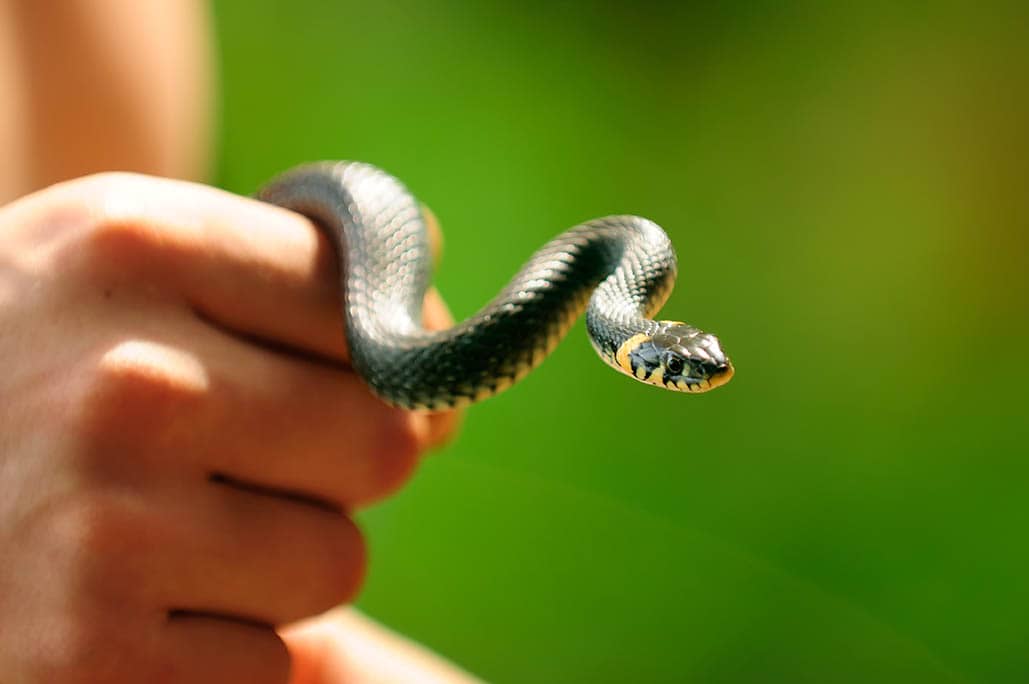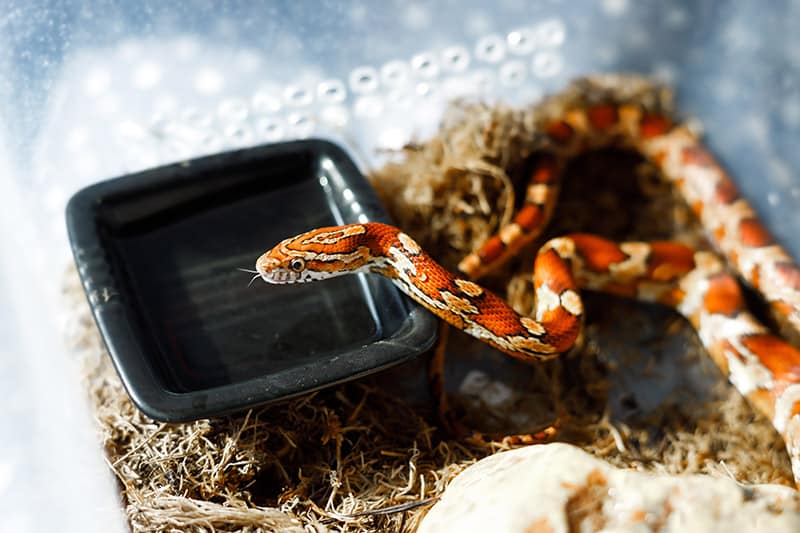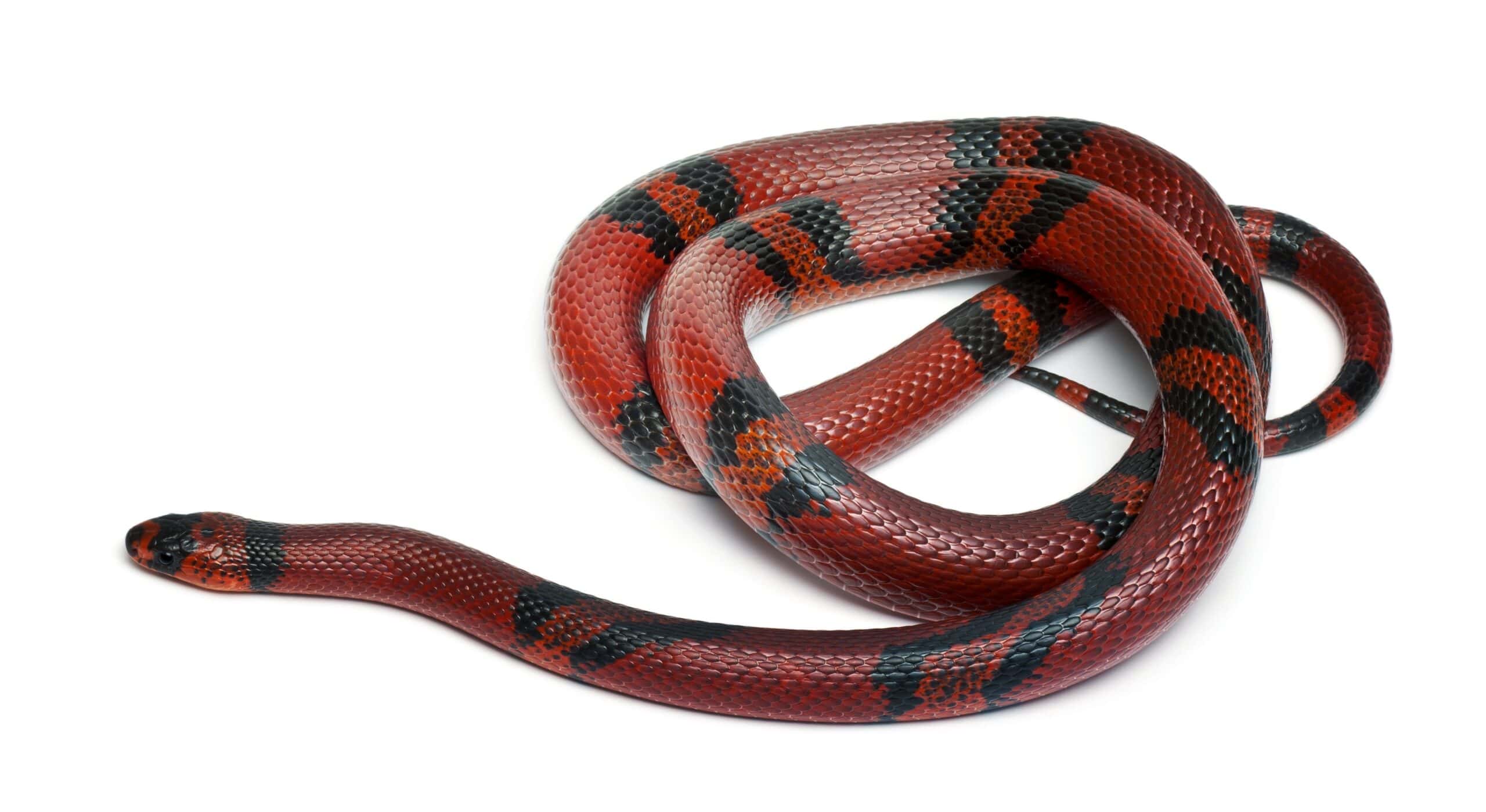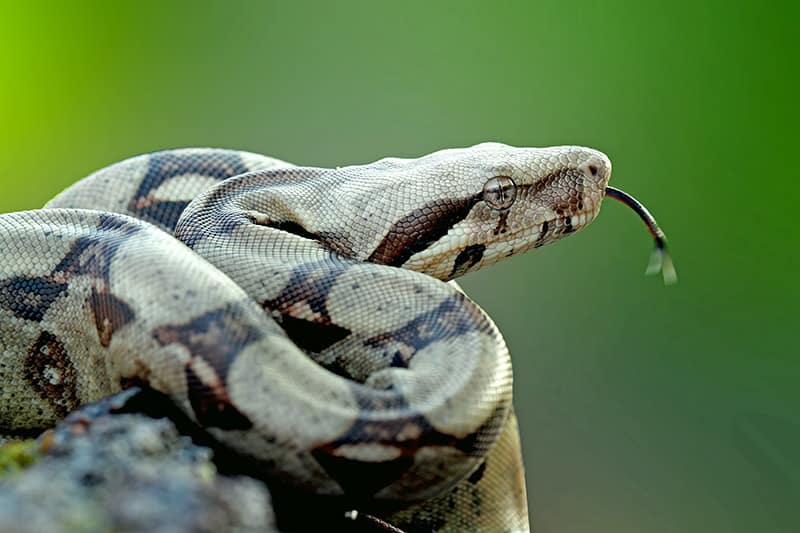The best types of pet snakes are suited to their keeper… and get great care!
There are many types of snakes, both small and large, kept as pets. With approximately 2,900 snake species found all across the world, its not surprising that there are all sorts of snakes readily available to choose from.
Many snakes make good pets because they are quite docile, easy to hold, and easy to care for. Snakes are very clean, virtually odorless, and they are quiet. Other than the large boas and pythons, they don’t eat much, so they are inexpensive to feed as well.
All Snakes are very agile animals with a similar body shape. But they do differ in size and temperament. Snakes range in size from a tiny 4 inches (10 cm) in length to over 30 feet (9 m). Those snakes kept as pets are generally species that are less than 5 feet in length. Exceptions to this are some of the larger boas and pythons. The lifespan of snakes kept in captivity is also variable. Common rat snakes and king snakes can live over 15 years while pythons and boas can live more than 20 years.
Snake types range from those that are great for beginners to those that need an experienced keeper. Their instinctive aggressiveness is quite variable. There are those that always bite, those that occasionally bite, and others that seldom or never bite. In general, captive bred snakes tend to have a more calm, relaxed nature, and are easier to tame than wild caught specimens. Different types of snakes will also have their particular feeding and care requirements.
When getting your first snake, its a good idea to take some time looking at and learning about the different types of snakes and then choose the right snake for you. Good beginner snakes are smaller in size, usually available as captive bred specimens, and have a more docile temperament. Some popular starter snakes of this sort include the king snake, corn snake, garter snake, rat snake, milk snake and the ball python.
- Learn more about herptiles: Reptile Care: Keeping Reptiles and Amphibians as Pets
Ball Python Care
Snake Facts
Snake Characteristics
Snakes come in a wide variety of sizes, colors, temperaments, and habits. These characteristics vary some with each snake species.
- Snakes range in size. Their bodies range in length from The smallest being the Leptotyphlops carlae which reaches about 4 inches (10 cm) in length to the longest being the Reticulated Pythons which can reach over 30 feet (9 m) in length. The heaviest snake is the Anaconda snake of South America. It is the largest snake in circumference, measuring up to three feet (one meter) around and reaches a length of about 25 feet (7.5 m).
- Snakes are made up of four parts; a head, a neck, a body and a tail.
- Snakes are reptiles with a lung or two, but no gills.
- They have no moveable eyelids and no external ear openings.
- Snakes have a retractile forked tongue which they use to pick up odors from the air and to taste.
- Snakes are limbless, have scales, and will molt or shed their skin between two to five times per year (young snakes can molt 8 to 12 times per year).
- They can have a long lifespan, ranging from about three years up to 25 or 30 years, depending upon the type of snake and its environment.
Snake Movement
Though they have no have no legs, snakes move in several ways. Some snakes move with a rectilinear movement. others have a serpentine movement and others move with a sidewindy motion, but no snake can move backward.
All snakes are able to swim, many snakes can climb and some can burrow. There is an Asian snake that can glide through the air by flattening its body and then using it like a parachute. Some water snakes flattened their tail and use it to propel themselves through the water.
Social Behaviors of Snakes
Most snakes are generally solitary in nature for most of the year, with some species congregating during breeding season or during hibernation. Other than that, there is little known about companionship behaviors. There are reports of siblings of an adder species staying together during all seasons, but this has not been determined as a regular behavior pattern, even among other adders.

Snake Cages
Your snake’s housing is what provides its sense of security. Provide an enclosure that is simple in design, secure, uncrowded, and that is easy to keep dry and clean. Understanding your snake’s characteristics will help you determine more about the type of cage or enclosure your pet will need. Check the snake guide describing your pet to find its particular housing needs. See: Snakes: Species Guides for All Types of Snakes
Snakes don’t play with toys, rather they rest a lot, eat a little, and will constantly be moving around their environment exploring, poking and prodding. Snakes are both strong and agile. They are not easily confined and if there is an unsecured opening, they will find it and escape. If the decor or water containers are too lightweight or if they are heavy but not solidly placed, snakes will knock them over and can possibly be injured. Most snakes are best housed singly. Many are cannibals, others that make great pets simple don’t make good cage mates, and with just one you lessen the chance of transferring diseases.
Cage supplies and requirements
- Snake Cages – A screen topped aquarium is often used to house a small snake. More elaborate enclosures are used for large species, like large terrariums and even special snake rooms.
- Cage Size – Housing size should have the diagonal of the cage at least as long as the snake.
- Cage top – The enclosure needs a secure, escape proof top or access opening.
- Ventilation – Good ventilation and air circulation are important to prevent excessive humidity. Humidity can cause bacterial and fungal growth, and these can lead to infections.
- Floor covering – The material on the floor, the substrate, should be absorbent (like bark or rabbit pellets) or else use a reptile carpet. It is not recommended to use gravel, stones, soil or dirt as they are hard to keep clean. Provide sand in a plastic box for burrowing snakes.
- Decor – Keep the decor simple and suitable for the type of snake you are housing.
- Hiding Place – All snakes need a hiding place of some sort. A climbing limb with vining, a bark slab, a piece of splinter-free driftwood, a box or a ceramic log placed on the cool side of the cage, all these can work well as hiding places.
- Plants – Plants are fine for some snake. Check to see if they are suitable for the type of snake you are housing.
- Water – There must to be fresh water for the snake to drink and occasionally bathe in. Provide a sturdy container for drinking water, and a removable bath tub.
Cage heating and lighting
Lighting
Provide a warm broad spectrum light 10 to 12 hours per day. For most snakes that are not nocturnal, natural daylight is ideal, though not usually practical. The next best solution is to provide artificial light. An ultraviolet light source, Vitalites, are better than fluorescent or incandescent light bulbs. You can gradually increase or decrease the number of hours of light in the spring, fall, and winter to simulate natural daylight.
Heating
Snakes generate little or no internal heat and they do not perspire. Heating is essential for snakes. Below a certain temperature the snake’s body simply does not work. Above a certain temperature their bodies will go out of control. Either extreme will kill a snake. They must rely on the environment to furnish the desired range of temperatures.
Most snakes will need a substrate heating device, but also a cool shade area to move to when they are too warm. Arrange the cage so your snake can find proper temperatures. Providing a thermal gradient in the aquarium works best, with a warm basking area on one end and a cool area on the other end.
- For an information on different types of heating devices, see Reptile Care: Heating

Snake Food and Feeding
All snakes are carnivores, and their digestive systems are designed to eat whole animals for a complete diet. They are never vegetarians. Their diets range from rodents, fish, worms, frogs, and amphibians to lizards, insects, and often times other snakes. Specific foods and how to feed are indicated in the snake guide describing your pet. You should sprinkle a vitamin supplement of calcium and vitamin D on their food.
Some of the rodents snakes will eat include mice, rats, pinkies and fuzzies (terms for baby and juvenile mice and rats), rabbits and chickens. These proteins form the basis of many snakes diets. They can be fed live or purchased frozen and completely defrosted before feeding. Be cautious when feeding live adult rats, and sometimes even mice. Snakes that do not feed immediately on an adult rodent run the risk of being bitten by a loose rat or mouse, and can be severely damaged.
Snake Breeding
Breeding snakes requires keeping records and close attention to many details regarding the snakes and their living conditions. The snakes need to be in good condition and of breeding age. Breeding is generally done in the winter so that the babies are born or hatched in the spring.
Sexing snakes is not particularly difficult, but it is easy to make mistakes. In general, females tend to be larger with more fat in their lower body. All snakes have a posterior opening called the “cloaca”, which is used for wastes and breeding. When this area is squeezed or probed just right, a bi-lobed reproductive organ called “hemipenes” will protrude on a male. For beginners, its a good idea to have an experienced snake breeder demonstrate the technique.
Here’s a general overview of snake breeding. This is just an introduction to what’s involved in the process. Different considerations are depending on the species, so research the species you are interested in breeding before attempting to mate your snake.
- Snakes being prepared for breeding should be well fed for about 4 months in the late fall. Both male and female need to put on weight.
- Then they need to be put in a cooling/hibernation state for about 3 months.
- After about 3 months start a warming period and again feed the snakes. Keep the temperature at proper levels for digestion but drop it some at night. During this time, if there is too much constant temperature, it will destroy fertility.
- During the warming period they should shed, and then within a couple of weeks be ready to mate.
- The female is then introduced into the male’s enclosure.
- If a female is ready to mate, she will allow the male to lay close to her, if not she will bunch up and attempt to avoid him. Take her out and try again in a day or two.
- It’s best to reintroduce the pair several times every few days until the female is not longer receptive. At that point she should be gravid.
- Gestation generally lasts from 28 to 45 days, depending on the species, with the female often reducing food intake and usually shedding a couple of weeks before laying. Female boas gestation can last 4 to 10 months and they will usually keep eating during this time.
- After laying, a female can be re-introduced to the male for another mating.
- For live bearing snakes, such as boa constrictors, the process is a bit different. They should still be well fed for several months, and then stop feeding them for two weeks prior to cooling. Then add one or more males to the female’s enclosure prior to the cooling period. Give them a slow cooling period for three weeks, and then three weeks more in the cooling state all without feeding. Then start them into a warming state again similar to other snakes. The gestation of female boas can last 4 to 10 months and they will usually keep eating during this time.
Where to Find Snakes
Beginner snakes are generally available for sale and are fairly inexpensive. You can buy snakes at pet store, online, or from breeders. You can also collect snakes where allowed.
Wild caught snakes are seasonal due to their breeding times and can be difficult to adapt to captivity. Although captive bred snakes are more expensive, they are generally easier to get. Other benefits of captive bred snakes is that they are often healthier than wild caught snakes, they adapt more easily to cage conditions, and they are relatively parasite free.
Snakes as Pets
People have a variety of reactions to reptiles, ranging from absolute intrigue and fascination, to varying degrees of distaste. Snakes are enjoyed for their interesting appearances and behaviors, making them a fascinating group of animals.
Why Snakes make good pets
There are a wide variety of docile, friendly snakes to choose from for a pet. As you learn about snakes and take good care of them you will find them to be amazing pets. As your skills and knowledge increase, you will gain an even greater appreciation of these incredible animals that are so different from ourselves.
- Snakes make ideal pets because they can take up a relatively small amount of space.
- They are easy to care for and their care is not particularly time consuming or expensive.
- Snakes are very clean and virtually odorless.
- They are not noisy or messy, and they don’t have to be fed everyday.
- Many snakes are quite docile and easy to hold
- Other than the large boas and pythons, they don’t eat much so they are inexpensive to feed

Is a snake the right pet for you?
Keeping a pet snake requires a commitment. Thoroughly research their care requirements and learn about the snake you are interested in to determine if it is the right pet for you. Here’s some facts about snakes that should be considered before deciding on this type of pet:
- Beginners do best starting with small common species that are quite hardy.
- Reptiles in general are not affectionate, cuddly pets and snakes are no exception.
- Many species of snakes are comfortable with handling, yet there are others that will stress easily.
- Snakes that are wild caught can be more prone to stress, so more difficult to maintain and keep healthy.
- Some snakes grow very large and take expert handling.
- Some snakes are venomous and so can pose a danger. These are kept as visual pets and should only kept by advanced keepers with plenty of experience.
What’s the best type of snake?
When deciding which snake is for you, think about what type is best suited to you. Considering each of these basic questions will help narrow down the snake selection to those species that best fit you:
- How much do you want to spend?
- How much space do you have for it?
- How hardy is it and how easy is it to feed?
- What color, shape and size do you want?
- How long will it live?
- Is the snake you want readily available?
Note: Many reptiles are protected so check with authorities in your area on laws governing your reptile selection.
Choosing a Pet Snake
There are a number of good snakes that make excellent pets for beginners, and many more for those that become advanced keepers. No matter what your skill level however, there are a few primary factors to consider when selecting any pet snake. In all cases, captive bred snakes are better choices than wild caught specimens. Wild caught snakes tend to be more nervous, are more difficult to tame, and may have parasites or diseases.
Types of pet snakes are grouped as beginner, or Intermediate and advanced, according to size, ease of care, personality and handleability, as well as availability and the costs associated with setup and maintenance.
Beginner Snakes

These pets are generally recommended as great snakes for any beginner. They are small to medium in size, usually available as captive bred specimens. They are easy to care for, have a more docile temperament, and generally easy to handle. Many good beginner snakes are relatively inexpensive to buy and maintain.
Some popular starter snakes of this sort include:
- Corn Snake – Elaphe guttata
The corn snake is one of the most popular pet snakes and one of the top choices for a beginner. They are small, easy to care for, and are morphs are available in many colors and patterns. - King Snake – Lampropeltis genus
There are a number of popular king snake species such as the Desert Kingsnake L. g. splendida, that is a subspecies of the Common King Snake Lampropeltis getula.
They make wonderful pet snakes, with regular handling they are gentle and docile, as well as easy to feed and very hardy. However they are carnivorous and will eat other snakes, so must be housed separately. - Milk Snake – Lampropeltis triangulum
This a very popular and favorite snake renown for being docile, and handleble. They are also easy to feed and very hardy. Milk snakes are very good looking, and do to selective breeding they come in many color variations of these snakes. Like other members of the Lampropeltis genus, they too are carnivores that will eat other snakes, so must be housed separately. - Garter Snake – Thamnophis sirtalis
Garter Snakes are one of the best, first snakes for a beginner. They are small, attractive and inexpensive. Being docile and even-tempered, they are very tolerant of frequent handling. - Rat Snake – Elaphe obsoleta
Though a little more skittish than a King Snake, the Rat Snake is a common favorite. With regular handling they will quickly become docile and even tempered, There are a number of varieties of Rat Snake available due to successful captive breeding. - Ball Python – Python regius
Ball Pythons are a very popular constrictor due to their small size, docile temperament, and being , reasonably priced. They topically don’t bite, but instead choose to coil tightly into the ball, which leads to their common name. They can live 20 to 30 years in a good home.
- Corn Snake – Elaphe guttata
Intermediate to Advanced Snakes

Larger snakes, like many of the boas and other constrictors, the more exotic snakes, and venomous snakes are best left to more experienced keepers. Many of these snakes require permits or licensing to keep, or other restrictions may apply, so be sure to check with the authorities in your area and state before obtaining them.
Large Snakes
The care and handling of larger snakes requires more space and strength. They are more costly to maintain and can be potentially dangerous. Some of the larger types of snakes that are available as pets include:
- Colombian Boa Constrictor (Boa constrictor imperator) – This snake is also known as the Common Boa and the Colombian “Red Tail” Boa. It is not as large as some constricting snakes, but can still be a handful.
- Burmese Python (Python molurus bivittatus) – This is an incredible snake which has fascinated keepers for many years, but it is also a huge snake. It is the 6 largest snakes in the world. It has been successfully bred in captivity and there are various color morphs available.
Exotic Snakes
The more exotic snake species are often less understood and generally there is less information available about keeping them in captivity. They can have are more difficult care requirements and be more costly to maintain. Some of the exotic types of snakes that are available as pets include:
- Green Tree Python – Morelia viridis
- Amazon Tree Boa or Garden Tree Boa – Corallus hortulanus
- Water snakes
Green Snakes
Green snakes, like the Rough Green Snake (Opheodrys aestivus) are often available as pets. They have a very pleasant temperament, but they are a more difficult snake to maintain in captivity,
Venomous Snakes
Venomous snakes can be found anywhere that non-venomous snakes are also found, though there are more venomous snakes in Southeast Asia than anywhere else. Rattlesnakes are found only in the western hemisphere. All snakes that live in the sea are venomous. Venomous snakes should only be kept by experienced professionals.

Handling Your Snake
To hold a snake, approach the cage slowly as this is the snakes home and it may try to defend it.
- If it is a tame snake, slowly reach in and grasp the snake firmly behind its head. Support it’s body with your other hand as you pick it up.
- If it is not tame, reach in and grasp it behind the head quickly, or use a snake stick.
Don’t handle a snake after handling its food, it can smell the food on your hands and may mistake your hand for its supper. Also, don’t handle a snake for two days after you’ve fed it as it needs time to digest its meal. Handling it too soon may make it regurgitate its food.
- Note: Always wash your hands before and after handling!
- Note: Always wash your hands before and after handling!
Featured Image Credit: pixel1, Pixabay
